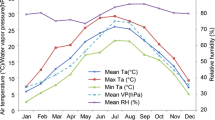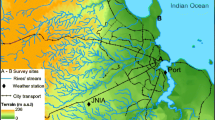Abstract
The aim of this paper was to study qualitatively and quantitatively the thermal perception and corresponding heat stress conditions that prevail in two schoolyards in a coastal city in central Greece. For this purpose, meteorological parameters (i.e., wind speed, temperature, relative humidity, solar radiation) were recorded at 70 and 55 measuring points in the schoolyards, from 14:00 to 15:30 local time, during May and June of 2011. The measuring points were distributed so as to get measurements at points (a) directly exposed to the sun, (b) under the shadow of trees and building structures, and (c) near building structures. Cluster analysis was applied to group observations and revealed places that are microclimatically homogeneous. Thermal perception and heat stress conditions were assessed by means of the physiologically equivalent temperature (PET, °C), and the results are presented in relevant charts. The impact of material’s albedo, radiation’s reflection by structures and obstacles, and different tree species on thermal perception and heat stress conditions was also assessed. The analysis showed that trees triggered a reduction of incident solar radiation that ranged between 79 and 94 % depending on tree’s species, crown dimension, tree height, and leaf area. PET values were mainly affected by solar radiation and wind speed. Trees caused a reduction of up to 37 % in PET values, while a 1-m s−1 increase in wind speed triggered a reduction of 3.7–5.0 °C in PET value. The effective shading area in the two schoolyards was small, being 27.5 and 11 %. The results of this study could be exploited by urban planning managers when designing or improving the outdoor environment of a school complex.






Similar content being viewed by others
References
Ali-Toudert F, Mayer H (2006) Numerical study on the effects of aspect ratio and orientation of an urban street canyon on outdoor thermal comfort in hot and dry climate. Build Environ 41:94–108
Ali-Toudert F, Mayer H (2007) Effects of asymmetry, galleries, overhanging facades and vegetation on thermal comfort in urban street canyons. Sol Energy 81:742–754
Baltas E (2007) Spatial distribution of climatic indices in northern Greece. Meteorol Appl 14:69–78
Bradshaw V (2006) The building environment: active and passive control systems, 3rd edn. Wiley, New York
Brown RD, Gillespie TJ (1995) Microclimate landscape design: creating thermal comfort and energy efficiency. Wiley, New York
Buratti C, Ricciardi P (2009) Adaptive analysis of thermal comfort in university classrooms: correlation between experimental data and mathematical models. Build Environ 44:674–687
Charalampopoulos I, Tsiros I, Chronopoulou-Sereli A, Matzarakis A (2013) Analysis of thermal bioclimate in various urban configurations in Athens, Greece. Urban Ecosyst 16:217–233
Christidou V, Tsevreni I, Epitropou M, Kittas C (2013) Exploring primary children’s views and experiences of the school ground: the case of a Greek school. Int J Environ Sci Edu 8:59–83
Cohen P, Potchter O, Matzarakis A (2012) Daily and seasonal climatic conditions of green urban open spaces in the Mediterranean climate and their impact on human comfort. Build Environ 51:285–295
Daskalaki GE, Temertzoglou GV (2011) Energy performance and indoor environmental quality in Hellenic schools. Energ Buildings 43:718–727
Dimoudi A, Nikolopoulou M (2003) Vegetation in the urban environments: microclimatic analysis and benefits. Energ Buildings 35:69–76
Epstein Y, Moran DS (2006) Thermal comfort and the heat stress indices. Ind Health 44:388–398
Fabbri K (2013) Thermal comfort evaluation in kindergarten: PMV and PPD measurement through data logger and questionnaire. Build Environ 68:202–214
Fahmy M, Sharples S, Yahiya M (2010) LAI based trees selection for mid latitude urban developments: a microclimatic study in Cairo. Egypt Build Environ 45:345–357
Fanger PO (1970) Thermal comfort: analysis and applications in environmental engineering. Danish Technical Press, Copenhagen
Fröhlich D, Matzarakis A (2013) Modeling of changes in thermal bioclimate: examples based on urban spaces in Freiburg, Germany. Theor Appl Climatol 111:547–558
Gagge AP, Stolwijk JAJ, Nishi Y (1971) An effective temperature scale based on a simple model of human physiological regulatory response. ASHRAE Trans 77:247–257
Gamson Danks S (2010) Asphalt to ecosystems: design ideas for schoolyard transformation. New Village Press, Oakland
Georgi NJ, Zafiriadis K (2006) The impact of park trees on microclimate in urban areas. Urban Ecosyst 9:195–209
Gramsch E, Cereceda-Balic F, Oyola P, Von Baer D (2006) Examination of pollution trends in Santiago de Chile with cluster analysis of PM10 and ozone data. Atmos Environ 40:5464–5475
Gulyás A, Unger J, Matzarakis A (2006) Assessment of the microclimatic and human comfort conditions in a complex urban environment: modelling and measurements. Build Environ 41:1713–1722
Hanna CK (1999) GIS for landscape architects. ESRI Press, California
Hassaan A, Mahmoud A (2011) Analysis of the microclimatic and human comfort conditions in an urban park in hot and arid regions. Build Environ 46:2641–2656
Heisler GM (1982) Reduction of solar radiation by tree crowns. The renewable challenge. In: Proceedings: 1982 Annual Meeting of the American Section of International Solar Energy Society 133–139, Houston
Herrmann J, Matzarakis A (2012) Mean radiant temperature in idealised urban canyons—examples from Freiburg, Germany. Int J Biometeorol 56:199–203
Höppe PR (1993) Heat balance modelling. Experientia 49:741–746
Höppe P (1999) The physiological equivalent temperature—a universal index for the biometeorological assessment of the thermal environment. Int J Biometeorol 43:71–75
Kalkstein LS, Tan G, Skindlov JA (1987) An evaluation of three clustering procedures for use in synoptic climatological classification. J Clim Appl Meteorol 26:717–730
Kefala-Kouraki A (2009) Environmental rehabilitation and schoolyards in Thessaloniki. A thesis submitted to the University of Thessaloniki for the degree of Msc in the Faculty of Environmental design of cities and buildings (in Greek)
Ketterer C, Matzarakis A (2014) Human-biometeorological assessment of heat stress reduction by replanning measures in Stuttgart, Germany. Landsc Urban Plan 122:78–88
Lin T-P (2009) Thermal perception, adaptation and attendance in a public square in hot and humid regions. Build Environ 44:2017–2026
Lin TP, Matzarakis A, Huang JJ (2006) Thermal comfort and passive design of bus shelters. Proceedings of the 23rd Conference on Passive and Low Energy Architecture (PLEA2006), International Society of Passive and Low Energy Architecture, Geneva, Switzerland
Lin T-P, Ho Y-F, Huang Y-S (2007) Seasonal effect of pavement on outdoor thermal environments in subtropical Taiwan. Build Environ 42:4124–4131
Lin T-P, Matzarakis A, Hwang RL (2010) Shading effect on long-term outdoor thermal comfort. Build Environ 45:213–221
Malone K, Tranter PJ (2003) Children’s environmental learning and the use, design and management of school grounds. Child Youth Environ 13:87–137
Matzarakis A, Mayer H (1996) Another kind of environmental stress: thermal stress. WHO News 18:7–10
Matzarakis A, Mayer H (1997) Heat stress in Greece. Int J Biometeorol 41:34–39
Matzarakis A, Mayer H, Iziomon M (1999) Applications of a universal thermal index: physiological equivalent temperature. Int J Biometeorol 43:76–84
Matzarakis A, Rutz F, Mayer H (2007) Modelling radiation fluxes in simple and complex environments—application of the RayMan model. Int J Biometeorol 51:323–334
Matzarakis A, Rutz F, Mayer H (2010) Modelling radiation fluxes in simple and complex environments: basics of the RayMan model. Int J Biometeorol 54:131–139
Mayer H, Höppe P (1987) Thermal comfort of man in different urban environments. Theor Appl Climatol 38:43–49
Mazon J (2014) The influence of thermal discomfort on the attention index of teenagers: an experimental evaluation. Int J Biometeorol 58:717–724
Mors ST, Hensen JLM, Loomans MGLC, Boerstra AC (2011) Adaptive thermal comfort in primary school classrooms: creating and validating PMV-based comfort charts. Build Environ 46:2454–2461
Nikolopoulou M, Lykoudis S (2007) Use of outdoor spaces and microclimate in a Mediterranean urban area. Build Environ 42:3691–3707
Papanastasiou DK, Melas D, Bartzanas T, Kittas C (2010) Temperature, comfort and pollution levels during heat waves and the role of sea breeze. Int J Biometeorol 54:307–317
Pomerantz M, Akbari H, Harvey JT (2000) Durability and visibility benefits of cooler reflective pavements. National Laboratory, Lawrence Berkeley, LBNL - 43443
Rivkin MS (2000) Outdoor experiences for young children. ERIC Digest, Charleston WV, ERIC Clearinghouse on Rural Education and Small Schools
Shashua-Bar L, Hoffman ME (2000) Vegetation as a climatic component in the design of an urban street: an empirical model for predicting the cooling effect of urban green areas with trees. Energ Buildings 31:221–235
Shashua-Bar L, Pearlmutter D, Erell E (2011) The influence of trees and grass on outdoor thermal comfort in a hot-arid environment. Int J Climatol 31:1498–1506
Sindosi OA, Katsoulis BDA, Bartzokas G (2003) An objective definition of air mass types affecting Athens, Greece; the corresponding atmospheric pressure patterns and air pollution levels. Environ Technol 24:947–962
Streiling S, Matzarakis A (2003) Influence of single and small clusters of trees on the bioclimate of a city: a case study. J Arboric 29:309–316
Svensson MK, Eliasson I (2002) Diurnal air temperatures in built-up areas in relation to urban planning. Landsc Urban Plan 61:37–54
Tan J, Zheng Y, Tang X, Guo C, Li L, Song G, Zhen X, Yuan D, Kalkstein AJ, Li F, Chen H (2010) The urban heat island and its impact on heat waves and human health in Shanghai. Int J Biometeorol 54:75–84
Theodosiou TG, Ordoumpozanis KT (2008) Energy, comfort and indoor air quality in nursery and elementary school buildings in the cold climatic zone of Greece. Energ Buildings 40:2207–2214
Wan KKW, Li DHW, Yang L, Lam JC (2010) Climate classifications and building energy use implications in China. Energ Buildings 42:1463–1471
Yilmaz S, Irmak MA, Matzarakis A (2013) The importance of thermal comfort in different elevation for city planning. Global Nest J 15:408–420
Acknowledgments
This work was funded by the Research Committee of the University of Thessaly under the project entitled “Contribution of rational landscape design to the improvement of bioclimatic parameters of school grounds and their utilization as a learning spaces” (Grant Code 4090.03).
We appreciate also the helpful comments of two anonymous reviewers.
Author information
Authors and Affiliations
Corresponding author
Rights and permissions
About this article
Cite this article
Antoniadis, D., Katsoulas, N., Papanastasiou, D. et al. Evaluation of thermal perception in schoolyards under Mediterranean climate conditions. Int J Biometeorol 60, 319–334 (2016). https://doi.org/10.1007/s00484-015-1027-5
Received:
Revised:
Accepted:
Published:
Issue Date:
DOI: https://doi.org/10.1007/s00484-015-1027-5




